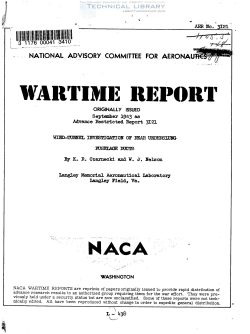naca-wr-l-438
- Version
- 135 Downloads
- 2.66 MB File Size
- 1 File Count
- April 3, 2017 Create Date
- April 3, 2017 Last Updated
Wind Tunnel Investigation of Rear Underslung Fuselage Ducts

A general investigation of cooling ducts located at
various positions on a model of a typical pursuiteair—
plane has been conducted in the NADA full-scale tunnel.
Results are given in the present report for a duct located
on the bottom of the fuselage with its inlet behind the
leading edge of the wing. This installation is designated
a rear underslung fuselage duct.
Because of the thick boundary layers that existed at
the inlets of rear underslung fuselage duets. serious
losses in total pressure occurred ahead of the heat a:—
changer. In order to eliminate these losses. tests were
made with special vane installations designed to avoid
boundary—layer separation and with ducts to bypass the
boundary layer away from the main cooling duet.
Good pressure recoveries were obtained in the duets
with the use of either the inlet guide—vane installation
or the boundary-layer bypass duct. Best 'efficiencies
were measured, however. with installations that had vanes
in the diffuser and in the duct outlet. The ratio of
duct inlet velocity to the stream velocity was shown to
be the most important parameter l'affecting the duct per—
formance; a -value of this parameter of about 0.6 was
shown to be a good design value- for the duct with or with—
out vanes and 0.36 was a-good value for the installation
with the boundary—layer bypass. At Values somewhat below
0.6 and O. 35, separation occurred ahead of the duct and,
at higher values. there was some tendency for the duct
lessee te" increase'." -== L‘ 'i" . h ““
Irraqoqor Ior -
-An investigati-on has been conducted in th-e -HAOA
full—scale tunnel of engine—charge—air and cooling-air
ducts located at several positions on the fuselage and
in the wing of a model of a pursuit airplane. The re—
sults of the investigation relating to_carburetor—air
ducts on the top of the fuselage and to cooling-air ducts
in the wing have been reported in references 1 and 2.
In the present report. results are given for tests of a
cooling duct installed on the bottom of the fuselage
with the inlet behind the leading edge of the wing. This
installation is designated a rear underslung fuselage
duct. '
The tests were directed toward the development of a
duct having the following desirable characteristics:
(1) Maximum conversion of the total pressure ahead
of the duct to total pressure ahead of the heat exchanger
(2) Satisfactory regulation of air—flow quantity
over the range of airplane flight conditions
(3) Low duct dragl particularly in the high—speed
flight condition
(4) High critical speed
| File | Action |
|---|---|
| naca-wr-l-438 Wind Tunnel Investigation of Rear Underslung Fuselage Ducts.pdf | Download |

Comment On This Post